 October/November 2014-
Vol. 69 October/November 2014-
Vol. 69
Scenes from Lebanon - A New Art Series
by David Kurani
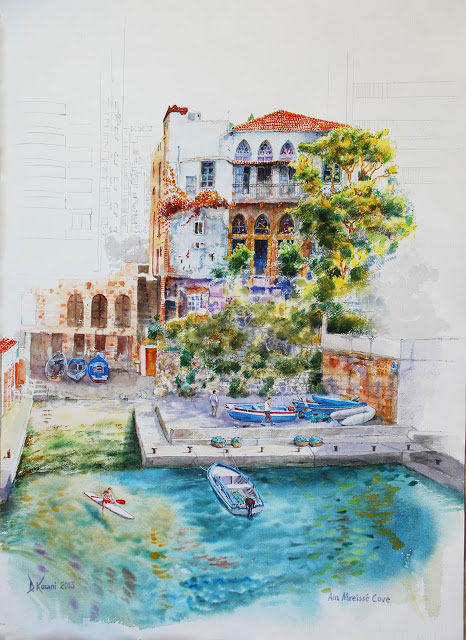
Ain
Mreisse Cove, watercolor, 76x57 cms, by
David Kurani
When
Saint Paul the Apostle sailed up the Mediterranean
coast on his last journey he made several stops on
the way. There are numerous little bays that
fishermen use to shelter their boats and repair
their nets, one or two even have small churches
marking sites where locals claim the saint landed on
his way. The cove pictured here is the last
remaining one in the capital city of Beirut and it
happens to be near my work. Who knows, maybe the
Apostle Paul also landed here.
The house is
an older style of architecture far more interesting
than the modern sea view apartment buildings around
it which pale by comparison (quite literally and
deliberately in this painting)
The youth on
the kayak (called a 'hasaki' meaning fish bone)
might be paddling out to check some lobster traps,
or practicing for a race, or just having some sport.
These hasakis combine the advantages of both canoes
and surfboards and are great for outings on the
clement Mediterranean coastal waters. I used to jump
off them to dive for sea urchins with their tasty
orange flesh inside the prickly spines! I think
there may be a lesson there: finding virtue beneath
a rough exterior.
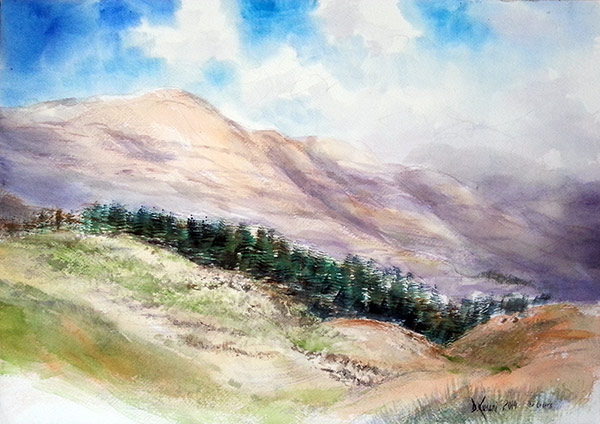
Cedars of Lebanon, watercolor,
27x35 cms, by David Kurani
The cedar
is the ' king of trees' and this grove is the
oldest in Lebanon with some trees over 2000
years old. They were high enough to be
practically inaccessible to the Phoenicians who
traded in cedar and fir through the ports of
Byblos (Gibileth or modern day Jubail), Sidon,
and Tyre.
They also
used cedars to build their boats. Why? They were
plentiful and the wood was immensely strong. It
has a triangular crystalline structure that
supports weight. It is not uncommon to see
branches carrying a great mass of snow extending
out horizontally from the trunk and hardly
bending down from the weight. The wood is also
aromatic- repelling insects and water pests.
Its
beautiful grain, also, must have recommended it
to Solomon who wanted it for his temple.So much
so that he concluded a very generous treaty with
neighboring King Hiram of Tyre to obtain vast
quantities of cedar wood and juniper from the
Lebanese slopes as it says in 1 Kings, 5 and 6.
Also mentioned are the skilled Lebanese workmen
( the 'Giblites'- citizens of Gebal as mentioned
above, the Greek Byblos just to the north of
Beirut and still called 'Jubail' ).
So in
total - what a grand creation is the cedar! (Yet
the voice of God can shatter it- Psalm 29)
Can it be that I can possibly grow into the
human equivalent? Psalm 92 verse12 seems to
indicate so... with God's help.
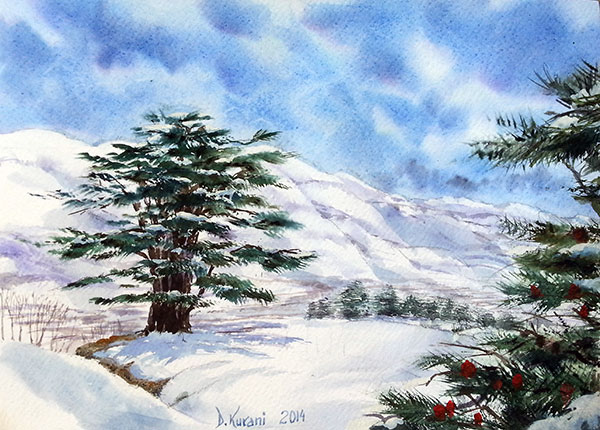
Cedars in the Snow, watercolor,
24x32 cms, by David Kurani
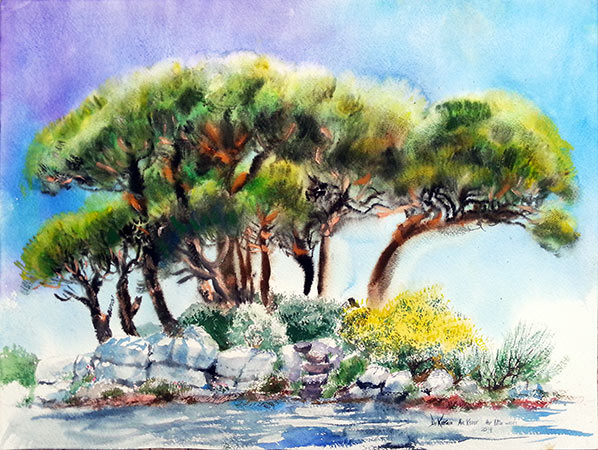 Pine Copse, watercolor, 62x46
cms, by David Kurani Pine Copse, watercolor, 62x46
cms, by David Kurani
If the cedar is 'the king of trees' here
in Lebanon, then the pine is the common man, so
plentiful is it here. Called variously the
umbrella pine, the stone pine, the pinion
pine,(and there may be still other labels) its
nuts enhance many local dishes and sweets, its
cones and branches fuel the village ovens,
carpenters use its wood and fieldworkers and
travelers its shade. Truly a giving tree - one to
be grateful for. I also happen to find it
beautiful and have painted many a study of it/them
in various lights and climes.
Last month I went back to the mountain
house my family used to occupy during the summer
months and saw this pine copse which was
important to us then. The underbrush which now
is thick as in this illustration, was cleared
away and I and my family spent many a happy hour
chatting, playing games, picnicing, and even
calling out and listening to the echo from the
facing hillside. So many good times! And in the
bad times just to go and sit there was truly a
medicine to recover a personal peace. I see how
much God loved me and delighted to give me good
things way before I knew him.
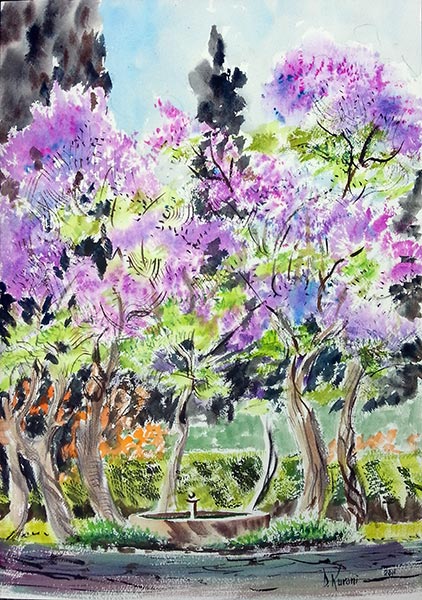
Jacaranda Trees, watercolor 27x35 cms, by
David Kurani.
Jacaranda trees
grow differently in different places. I was told
that in the Brazilian rainforests they grow tall
and so thickly that they form a canopy solid
enough for small animals to walk on some 40 feet
above the ground. But here in Lebanon they
branch out like lace and cover themselves (and
the ground around) with myriad purple blossoms.
Glorious!
Their colors
are so showy l am reminded of the story of the
little boy who said "Isn't God great! Just think
- he could have done it all in black and white!"
These here are in the garden of the house of
the president of the university l teach in.
While painting them I had the thought: Who
said plants don't move? I mean besides upwards
and outwards. To the artist's eye these trees
with their sinuous swaying and striking colors
remind me of maidens dancing at a wedding; a
lot of movement there! (cf. the five wise
virgins admitted into the party).
Another thought: My parents were
married in this very garden way back in 1933.
The ceremony was officiated by a Greek
Orthodox priest for my father's side of
things, and a Protestant minister for my
mother's. I certainly am grateful to God for
this early 'ecumenical convergence' in that
one of the results was me!
David Kurani is a noted Lebanese
landscape artist. He teaches classes in art and
theater at the American University of Beirut,
Lebanon. David has exhibited widely in art
galleries and private collections throughout
Lebanon, Europe, and the USA. He and his wife
Gisele are active members of the People of God
in Lebanon, a member community of the Sword of
the Spirit.
.
|
. |
|



 Pine Copse, watercolor, 62x46
cms, by David Kurani
Pine Copse, watercolor, 62x46
cms, by David Kurani
